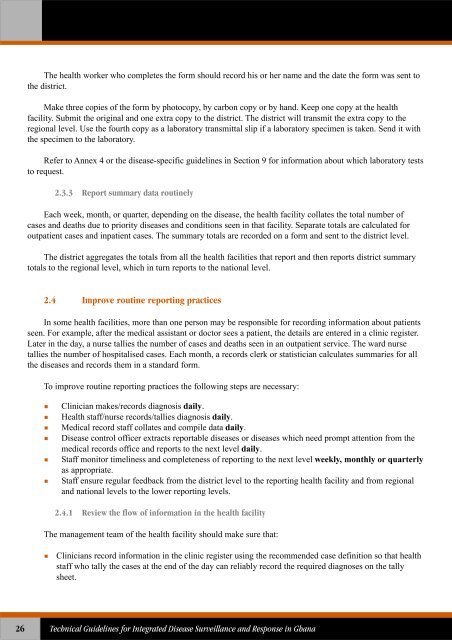Technical Guidelines for Integrated Disease Surveillance ... - PHRplus
Technical Guidelines for Integrated Disease Surveillance ... - PHRplus
Technical Guidelines for Integrated Disease Surveillance ... - PHRplus
You also want an ePaper? Increase the reach of your titles
YUMPU automatically turns print PDFs into web optimized ePapers that Google loves.
The health worker who completes the <strong>for</strong>m should record his or her name and the date the <strong>for</strong>m was sent tothe district.Make three copies of the <strong>for</strong>m by photocopy, by carbon copy or by hand. Keep one copy at the healthfacility. Submit the original and one extra copy to the district. The district will transmit the extra copy to theregional level. Use the fourth copy as a laboratory transmittal slip if a laboratory specimen is taken. Send it withthe specimen to the laboratory.Refer to Annex 4 or the disease-specific guidelines in Section 9 <strong>for</strong> in<strong>for</strong>mation about which laboratory teststo request.2.3.3 Report summary data routinelyEach week, month, or quarter, depending on the disease, the health facility collates the total number ofcases and deaths due to priority diseases and conditions seen in that facility. Separate totals are calculated <strong>for</strong>outpatient cases and inpatient cases. The summary totals are recorded on a <strong>for</strong>m and sent to the district level.The district aggregates the totals from all the health facilities that report and then reports district summarytotals to the regional level, which in turn reports to the national level.2.4 Improve routine reporting practicesIn some health facilities, more than one person may be responsible <strong>for</strong> recording in<strong>for</strong>mation about patientsseen. For example, after the medical assistant or doctor sees a patient, the details are entered in a clinic register.Later in the day, a nurse tallies the number of cases and deaths seen in an outpatient service. The ward nursetallies the number of hospitalised cases. Each month, a records clerk or statistician calculates summaries <strong>for</strong> allthe diseases and records them in a standard <strong>for</strong>m.To improve routine reporting practices the following steps are necessary:Clinician makes/records diagnosis daily.Health staff/nurse records/tallies diagnosis daily.Medical record staff collates and compile data daily.<strong>Disease</strong> control officer extracts reportable diseases or diseases which need prompt attention from themedical records office and reports to the next level daily.Staff monitor timeliness and completeness of reporting to the next level weekly, monthly or quarterlyas appropriate.Staff ensure regular feedback from the district level to the reporting health facility and from regionaland national levels to the lower reporting levels.2.4.1 Review the flow of in<strong>for</strong>mation in the health facilityThe management team of the health facility should make sure that: Clinicians record in<strong>for</strong>mation in the clinic register using the recommended case definition so that healthstaff who tally the cases at the end of the day can reliably record the required diagnoses on the tallysheet.26<strong>Technical</strong> <strong>Guidelines</strong> <strong>for</strong> <strong>Integrated</strong> <strong>Disease</strong> <strong>Surveillance</strong> and Response in Ghana















